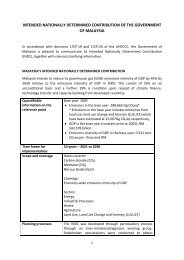RP-01638
RP-01638
RP-01638
Create successful ePaper yourself
Turn your PDF publications into a flip-book with our unique Google optimized e-Paper software.
Sri Lanka<br />
Pathirana Dharmadasa,<br />
lJpali Wickramasinghe, and<br />
Douglas Chandrasiri<br />
The majority of the rural people in Sri Lanka<br />
obtain water for daily use from rivers, canals,<br />
lakes, irrigation tanks, and uncovered wells.<br />
The water from such sources is often unsuitable<br />
for drinking and most other domestic<br />
purposes. Because few people boil the water<br />
before drinking it, this results in many<br />
diseases: a fact that village people do not<br />
understand.<br />
The Sarvodaya Movement is playing a<br />
major role in setting up health-education<br />
programs and in providing facilities for<br />
improving the health of the rural masses in<br />
Sri Lanka. One composent of this program is<br />
the covered-wells program (Fig. 1). The main<br />
emphasis of this program is the introduction<br />
of low-cost handpumps made from locally<br />
available materials as a means of providing<br />
clean drinking water for household use.<br />
During this project, three new designs were<br />
developed for the above-ground components<br />
of the Waterloo pump developed with<br />
funding from the International Development<br />
Research Centre (IDRC). As well, several<br />
modifications were made to the piston and<br />
check valve, which was used in place of a foot<br />
valve, to make the pump easier to manufacture<br />
with local resources. The goal of this<br />
design work was to develop a pump that<br />
incorporated the following features: the use<br />
of low-cost materials available in Sri Lanka;<br />
easy maintenance and repair without the<br />
need for highly skilled labour; and the use of<br />
polyvinyl chloride (PVC) plastic to eliminate<br />
corrosion problems.<br />
Organization of the Project<br />
A preliminary survey was undertaken in<br />
January 1979 in several villages in the districts<br />
of Galle, Matara, and Hambantota to investigate:<br />
the economic situation in the villages;<br />
the existing social conditions; the irrigation<br />
facilities; and the attitudes of the villagers<br />
toward handpumps. Based on the findings of<br />
this survey, it was initially decided to install<br />
60 pumps in six villages, but later, due to<br />
Fig: 1. View of well showing drainage channel to remove spilled water and stone layer to assist drainage.<br />
11



